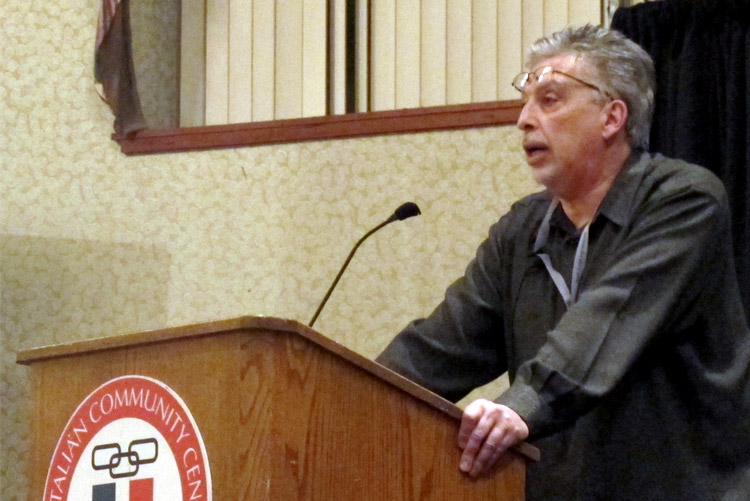Prescription Drugs Lead Way to Heroin
Prescriptions for opioid painkillers have nearly tripled in 20 years. Part 2 of series.

Milwaukee police officer Bodo Gajevic addresses the audience at a town hall meeting regarding heroin and opioid use in the city. Photo by Wyatt Massey.
Addiction typically starts at home with legal drugs, according to Rusty Payne, national spokesperson for the U.S. Drug Enforcement Administration. “It all starts with the pills.”
Doctors are not only distributing a greater number of painkillers than in previous decades, they are also prescribing them too often, said Dr. Michael McNett of the Milwaukee Medical Society.
In 2013, the most recent year for which data are available, almost 207 million prescriptions were written for opioids, such as OxyContin, Vicodin and Demerol. In 1991, doctors wrote 76 million prescriptions for such drugs, according to the National Institute on Drug Abuse.
The United Nations Office on Drugs and Crime reported that the amount of painkillers prescribed in 2010 was so large that every American adult could take a pill every four hours for an entire month. The United States makes up almost 5 percent of the world’s population, yet consumes 80 percent of its narcotics.
More than half of prescription drug abusers in 2014 reported getting pills from a friend or relative, and more than half of young heroin users who inject the drug said they abused prescription opioids first, according to the National Institute on Drug Abuse. Users can take prescription painkillers the same way they can take heroin, by crushing and snorting or injecting. Since heroin produces a more intense high at a cheaper price than prescription drugs, painkillers start to look less like a gateway to heroin and more like a highway.
This exposure fundamentally changes brain chemistry by raising the amount of chemicals the brain requires for normal function. The user needs to take drugs more frequently or in higher doses to experience the same euphoria. “When you become an opiate addict, your body craves and craves and craves,” Payne said.
Withdrawal affects every user differently, but a high drug tolerance typically correlates with stronger withdrawal symptoms. Injecting causes an almost immediate high because blood carries the drug directly to the brain, but the chemicals are used up quickly, giving way to a dramatic crash. A body coming off such an intense high can experience a wrenching seesaw between cold sweats and hot flashes, vomiting and diarrhea.
When the body abruptly comes off of a drug high, basic functions, such as getting out of bed or going to work, seem impossible without heroin.
Clouded thinking produced by heroin dependence or withdrawal dramatically increases the risk of a fatal overdose. A typical hit of heroin causes the body to relax. The heart rate decreases and breathing slows. Ingest too much heroin and the body forgets to breathe. Blood pressure drops so low that blood barely circulates to the organs that are in desperate need of it. Brain cells start to die after five minutes without oxygen.
Drug poisoning killed nearly 44,000 people in the United States in 2013 and was the number one cause of injury-related deaths in the country, according to the National Center for Health Statistics. Through November 2015, Milwaukee County had 244 drug-related deaths, which is on pace to eclipse any year dating back to 2002.
The brain’s neural pathways cannot heal themselves once they are changed, said Dr. John Mantsch, professor of biomedical sciences at Marquette University. These changes stay with the user, regardless of whether it has been 10 minutes or 10 years since the last high. People who achieve sobriety have a greater risk of relapsing because the neural pathways are changed. Mantsch calls heroin addiction the “battle that lasts a lifetime.”
This story was originally published by Milwaukee Neighborhood News Service, where you can find other stories reporting on fifteen city neighborhoods in Milwaukee.
More about the Opioid Crisis
- Baldwin Backed Legislation to Crack Down on Fentanyl Traffickers Heads to President’s Desk - U.S. Sen. Tammy Baldwin - Apr 24th, 2024
- Legislature Stalls Opioid Settlement Funds. Again - Erik Gunn - Apr 23rd, 2024
- Milwaukee Bucks Legend Marques Johnson Joins Forces with Serenity Inns to Combat Opioid Epidemic in Milwaukee - Serenity Inns - Apr 23rd, 2024
- Law Enforcement Agencies Awarded Grants from State Opioid Settlement Funds - Wisconsin Department of Health Services - Apr 18th, 2024
- MKE County: County Wins Award for Opioid Settlement Fund Usage - Graham Kilmer - Apr 4th, 2024
- MKE County: County Offering $2.8 Million For Opioid Addiction Programs - Graham Kilmer - Mar 28th, 2024
- Senator Baldwin Calls on House to Pass Bill that Cracks Down on Fentanyl Traffickers - U.S. Sen. Tammy Baldwin - Feb 15th, 2024
- Attorney General Josh Kaul announces $350 million settlement with marketing firm over its role in opioid epidemic - Wisconsin Department of Justice - Feb 1st, 2024
- Grants Will Fund Recovery Housing For Those Facing Homelessness and Battling Opioids - Margaret Faust - Jan 12th, 2024
- Baldwin Helps Advance Bipartisan Bill to Address Opioid and Fentanyl Crisis - U.S. Sen. Tammy Baldwin - Dec 14th, 2023
Read more about Opioid Crisis here
















